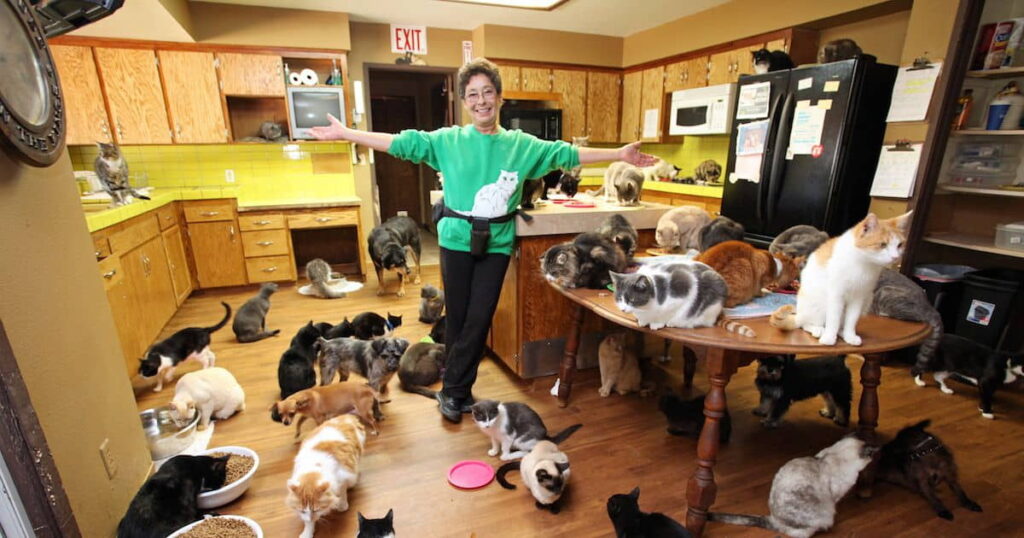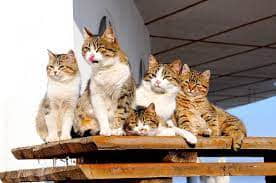Jacque Lynn Schultz, C.P.D.T., Companion Animal Programs Adviser. National Outreach
When living with cats, how many is too many? Due to variations in feline social behavior, there is no one-size-fits-all answer. For example, studies of barn cats showed that adult male cats usually preferred to live by themselves, while females lived in matrilineal communities usually numbering no more than ten.

Cats are territorial creatures. Indoor-only cats have their territory limited by the size of the home, although some restrict themselves further, to certain areas within the residence. A free-roaming cat’s territory is defined by individual personality, access to food and shelter, and sexual status. Intact males usually roam over a greater area than females, loosely attaching themselves to several female colonies.
This Land is My Land
Felines stake their claims by scratching, spraying and otherwise scent-marking with glands found on their faces, chins, feet and tails. Cats may increase marking behavior if they perceive a change in their environment, whether it be a new cat, a new guest or a new piece of furniture. While not exactly a “keep out” sign, marking seems to make the marker feel more secure in a shared space.
Territories can overlap and it is usually the more assertive cat who wins access at prime times. In a multi-cat household, for example, the same cat may claim the window ledge whenever the sun is in perfect position, or assume ownership of the bed pillow each night at lights out. Other cats can beit those places at different times, but if they try to visit at the best time, a squabble will usually break out until the more assertive cat wins.

The invasion of a cat’s territory by a new feline can lead to social frustration, which can manifest itself in a variety of ways. According to Dr. Bonnie Beaver in “Feline Behavior: A Guide for Veterinarians,” (W.B. Saunders Company, 1992), “Signs of social stress vary from aggression to catalepsy (freezing up). In the middle of this gamut of reactions are failure to bury feces, house soiling, insufficient grooming, excessive, grooming, overeating, anorexia, diarrhea, constipation, social withdrawal, vomition, and chronic piloerection (hair standing on end)” – all in addition to immunosuppression.
It is not unusual in a multi-cat household to witness the occasional hiss and swat, but you may find that two of your cats have had more than a simple falling out. In severe cases of social aggression, in which one cat takes an immense dislike to another and constantly tries to run the “pariah” off, hounding him whenever he attempts to leave the hiding place, finding a new home for the “pariah” often is the kindest thing to do.
Meow Mixing
The introduction of additional cats to the household should not be taken lightly. Too often, pet owners want to rush the process, expecting instant friendship. At minimum, allow two weeks of social isolation from the other cats in the home (but not human family members) before permiting a new addition to come face-to-face with resident felines. This routine enables the resident cat or cats to become used to the odor of another cat on their turf without having to take on the newcomer physically. More complicated introductions may call for the use of cattery cages or screened doors. These will allow cats to be nearly side-by-side at mealtimes yet unable to injure one another.
The stress accompanying lengthy introductions can be reduced by remembering:
- If you are currently cat-less but know you want two cats, consider adopting littermates or adults from the same household.
- If you already have a young or middle-aged cat, consider a cat who is three- to eight-months old. Introductions usually are smoother when bringing in a sexually immature and physically smaller cat.
- If you can get a history, look for a cat who stayed with his or her littermates until nine- to ten- weeks of age. These cats tend to be much more cat-friendly than orphaned cats or those less experienced with other cats.
- In order to prevent spraying troubles, try to avoid bringing in adult males until they are neutered.
While not all cats are inherently social animals, many thrive amongst their own kind. Making a thoughtful selection is one proven way to increase your chances of creating feline harmony.
Wondering about How To Choose The Right Cat Litter for Your Cat? Check it out on our latest post!
